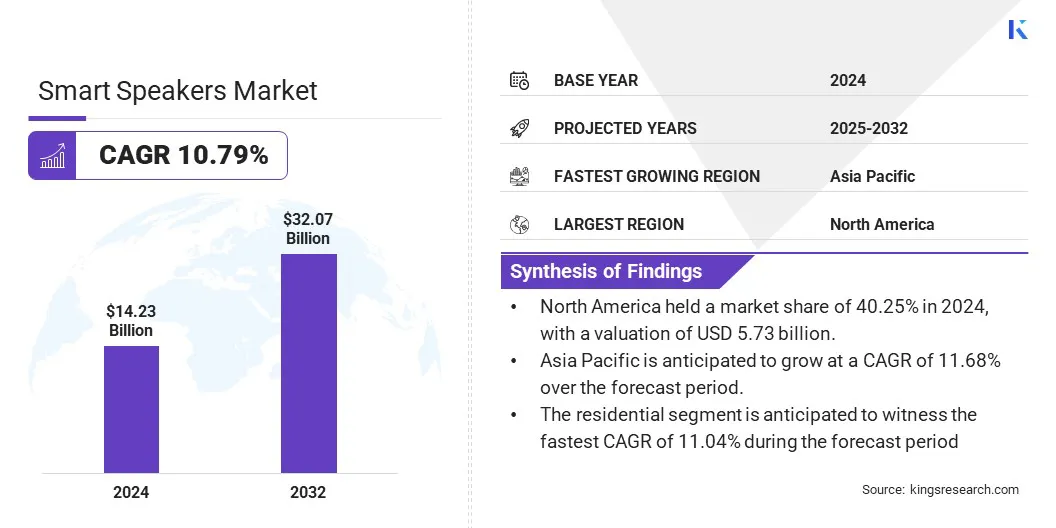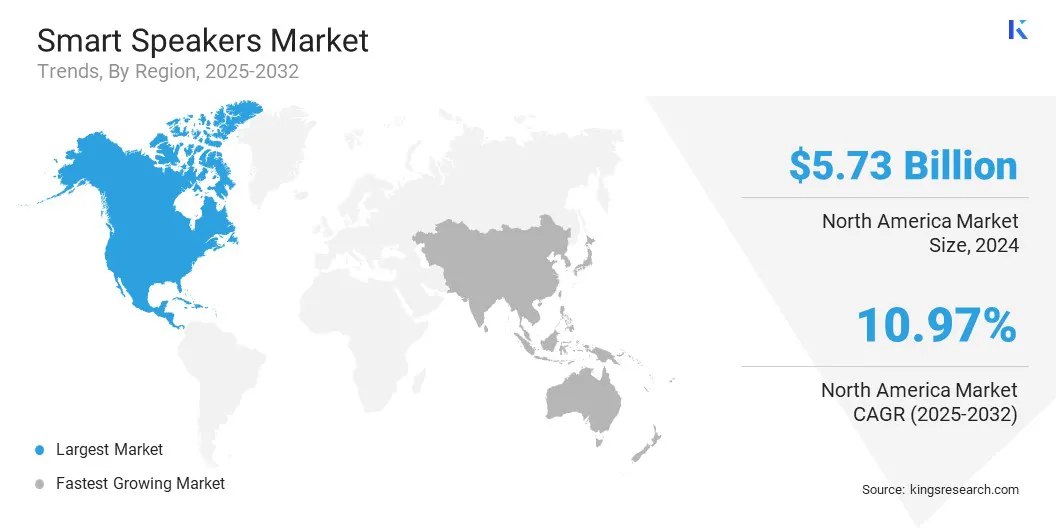Smart Speakers Market Overview
The global smart speakers market size was valued at USD 14.23 billion in 2024 and is projected to grow from USD 15.66 billion in 2025 to USD 32.07 billion by 2032, exhibiting a CAGR of 10.79% during the forecast period.
The market is driven by the rising adoption of smart homes, with more consumers integrating connected devices for a seamless living experience. Smart speakers act as centralized control hubs, allowing users to operate lighting, security systems, entertainment units, and other smart appliances through intuitive voice commands.
Key Market Highlights:
- The smart speakers market size was recorded at USD 14.23 billion in 2024.
- The market is projected to grow at a CAGR of 10.79% from 2025 to 2032.
- North America held a market share of 40.25% in 2024, with a valuation of USD 5.73 billion.
- The android-based segment garnered USD 6.44 billion in revenue in 2024.
- The bluetooth/wi-fi segment is expected to reach USD 24.66 billion by 2032.
- The residential segment is anticipated to witness the fastest CAGR of 11.04% during the forecast period
- The online segment garnered USD 10.06 billion in revenue in 2024
- The wireless segment held 79.63% of the market in 2024
- Asia Pacific is anticipated to grow at a CAGR of 11.68% over the forecast period.
Major companies operating in the smart speakers industry are Amazon.com, Inc, Google, Apple Inc, Sonos, Inc., Bose Corporation, Incorporated, Xiaomi, Samsung, SONY ELECTRONICS INC., Huawei Device Co., Ltd, Koninklijke Philips N.V., Baidu, Zebronics India Pvt. Ltd, VIZIO, Inc and Masimo.

Additionally, growing consumer preference for energy-efficient and durable smart speakers is driving innovation in the market. To meet the demand manufacturers are focusing on delivering longer battery life, fast charging capabilities, and robust designs that withstand various environments.
- In September 2024, Huawei launched the Sound Joy 2 smart speaker in China, available in Bluetooth and smart variants. The smart version supports voice control, smart home integration, WLAN connectivity, and online music streaming. These models feature Huawei Sound acoustic technology, IP67 durability, 26-hour battery life, and 40W fast charging, highlighting Huawei’s focus on high-performance, connected audio devices.
Expansion into the Premium Audio Segment
The market is benefiting from a rising focus on premium audio offerings. As leading manufacturers are focusing on integrating high-fidelity sound systems, spatial audio, and advanced technologies to attract audiophiles consumers.
Premium smart speakers are offering enhanced audio experiences, combining voice assistant functionality with superior sound quality. This shift is helping brands differentiate their products in a saturated market and capture a higher-value customer base.
Additionally, partnerships with luxury audio brands and the rise in smart home entertainment setups are further driving demand for premium smart speakers, contributing to the market’s expansion.
- In November 2024, Bose Corporation acquired the McIntosh Group to expand its portfolio into the luxury audio segment. This acquisition enables Bose to integrate its advanced audio technologies into high-end systems and enhance its smart speaker offerings.
Data Security Concerns
A key challenge in the smart speakers market is the growing scrutiny over data security and privacy risks associated with smart speakers. These devices rely on continuous voice input which raises concerns about the collection, storage, and potential misuse of sensitive personal information. Additionally, incidents involving unauthorized access, data breaches, and voice recording leaks are limiting the broader adoption of smart speakers.
To address this, companies are implementing advanced encryption methods to protect voice data during transmission and storage. They are enhancing user authentication features, such as voice recognition and multi-factor authentication, to prevent unauthorized access.
Additionally, manufacturers are improving transparency by offering user-friendly privacy controls, including options to review, manage, or delete stored voice data, in line with evolving regulatory and consumer expectations.
Integration with Smart TVs and Home Ecosystems
Integration with smart TVs and home ecosystems is emerging as a key trend inthe the market. Consumers are increasingly seeking seamless connectivity between their smart speakers, televisions, and other connected home devices to create a unified and convenient smart home experience. This integration enables enhanced voice control, synchronized media playback, and centralized management of multiple devices, boosting user engagement and satisfaction.
- In July 2024, Apple introduced the HomePod mini in a new midnight color, expanding its lineup of compact smart speakers. Available in yellow, orange, blue, and white variants, the midnight HomePod mini offers seamless integration with voice control and smart home capabilities.
Smart Speakers Market Report Snapshot
|
Segmentation
|
Details
|
|
By OS Type
|
Android-based, IOS-based, WebOS-based
|
|
By Technology
|
Bluetooth/Wi-Fi, Near Field Communication (NFC), Others
|
|
By Application
|
Residential, Commercial
|
|
By Distribution Channel
|
Online, Offline
|
|
By Power Source
|
Wireless, Wired
|
|
By Region
|
North America: U.S., Canada, Mexico
|
|
Europe: France, UK, Spain, Germany, Italy, Russia, Rest of Europe
|
|
Asia-Pacific: China, Japan, India, Australia, ASEAN, South Korea, Rest of Asia-Pacific
|
|
Middle East & Africa: Turkey, U.A.E., Saudi Arabia, South Africa, Rest of Middle East & Africa
|
|
South America: Brazil, Argentina, Rest of South America
|
Market Segmentation:
- By OS Type (Android-based, IOS-based, WebOS-based): The android-based segment earned USD 6.44 billion in 2024 due to its wide compatibility and extensive app ecosystem.
- By Technology (Bluetooth/Wi-Fi, Near Field Communication (NFC), Others): The bluetooth/wi-fi segment held 75.54% of the market in 2024, due to its seamless connectivity and longer range.
- By Application (Residential, Commercial): The residential segment is projected to reach USD 27.62 billion by 2032, owing to increased smart home adoption and convenience.
- By Distribution Channel (Online, Offline): The online segment is anticipated to witness the fastest CAGR of 11.25% during the forecast period due to the growing e-commerce penetration.
- By Power Source (Wireless, Wired): The wireless segment earned USD 11.33 billion in 2024 owing to rising demand for portability and ease of installation.
Smart Speakers Market Regional Analysis
Based on region, the global market has been classified into North America, Europe, Asia Pacific, Middle East & Africa, and South America.

The North America smart speakers market accounted for a share of 40.25% in 2024, with a valuation of USD 5.73 billion. This dominance is driven by its advanced R&D capabilities, widespread adoption of emerging technologies, and strong presence of key industry players.
The robust ecosystem in asia pacific supports continuous innovation and early integration of next-generation features such as voice interface in consumer devices. The market also benefits from advancements audio input technologies that enhance voice recognition, responsiveness, and efficiency in smart speaker performance.
- In December 2024, Syntiant Corp. acquired the Knowles Corporation’s Consumer MEMS Microphones (CMM) business for USD 150 million in cash and stock. Through this acquisition syntiant corp. aims to strengthen its position in advanced audio input technologies, enabling more efficient and responsive voice interfaces in smart speakers and IoT devices.
The Asia Pacific smart speakers industry is set to grow at a robust CAGR of 11.68% over the forecast period. This growth is fueled by rising demand for localized, multifunctional devices that cater to diverse consumer needs. Increasing adoption of digital payment technologies, particularly in countries such as India, is fueling the deployment of smart speakers in retail environments.
Advancements in smart speakers such as digital payment and 4g connectivity are making these devices more practical for daily commercial use. Additionally, government support for digital transformation and the rise of domestic manufacturing are encouraging innovation and affordability supporting the market growth.
- In May 2025, PhonePe introduced its next-generation smart speaker designed to enhance the digital payment experience for offline merchants across the country. The new speaker features 4G connectivity, faster charging, and extended battery life to suit retail environments.
Regulatory Frameworks
- In the U.S., Federal Trade Commission (FTC) oversees the advertising and marketing of smart speakers, to prevent false or misleading claims. FTC investigates data privacy concerns and ensures that smart speaker manufacturers adhere to fair information practices.
- In India, the Bureau of Indian Standards (BIS) mandates that all smart speakers, both domestic and international, must be registered under its Compulsory Registration Scheme (CRS).
Competitive Landscape
Major players in the smart speakers market are forming strategic acquisitions to gain advanced AI technologies and expertise. They are investing in AI capabilities to enhance on-device processing, minimize latency, and stronger data privacy.
Additionally, they are enabling advanced features such as multimodal interactions combining voice, visuals, and contextual understanding on devices to deliver faster, more secure, and personalized user experiences.
- In August 2024, Amazon signed an agreement to acquire Perceive, a San Jose-based chip maker and AI model compression company, for USD 80 million. The acquisition aims to enhance on-device AI performance for smart speakers.
Key Companies Smart Speakers Market:
- Amazon, Inc
- Google
- Apple Inc
- Sonos, Inc.
- Bose Corporation
- Xiaomi
- Samsung
- SONY ELECTRONICS INC.
- Huawei Device Co., Ltd
- Koninklijke Philips N.V.
- Baidu
- Zebronics India Pvt. Ltd
- VIZIO, Inc
- Altec Lansing
Recent Developments (Product Launch)
- In May 2024, JBL launched its retro-inspired Authentics Series in India, featuring models 200, 300, and 500. The series blends vintage aesthetics with modern audio features, including Dolby Atmos and 360-degree immersive sound. The Authentics 300 offers portability with Wi-Fi, Bluetooth, and an 8-hour battery life.
- In January 2024, Sonos introduced its new 8″ In-Ceiling Speaker, developed in collaboration with Sonance. Through this launch, Sonos aims to expand its architectural line of passive speakers. The speaker is engineered for seamless in-ceiling installation and high-performance audio delivery. Key features include an enlarged woofer paired with a high-excursion motor for deep bass and balanced midrange, as well as a 30mm tweeter with an optimized waveguide to enhance high-frequency dispersion and even sound distribution.


